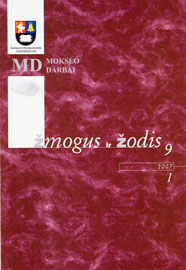Dviskiemenių e kamieno daiktavardžių kirčiavimo variantai pietų aukštaičių ir rytų aukštaičių vilniškių šnektose
Varieties ofAccentuation: Disyllabic e-stems in Southern and Eastern Sub-dialects of Vilnius Region Highlanders
Author(s): Vilija Lazauskaitė-RagaišienėSubject(s): Language and Literature Studies
Published by: Vytauto Didžiojo Universitetas
Keywords: noun; ė-stem; accentual variety; oxitone; baritone; metatony.
Summary/Abstract: Variation in the accentuation of declinable words as they occur in southern and eastern dialects of Vilnius region highlanders has hardly been re-searched. The paper focuses on several accentuation patterns of disyllabic e-stem nouns of feminine gender frequently found in the area of the above dialects, for example: laumė (2) / laumė (4), saulė (1) I saulė (3). The investigation aims at identifying causes of parallel patterns and their accentuation tendencies. The material for the present investigation has been collected from various sources. The research has clearly shown that the historic baritone and oxitone accentuation patterns are being replaced in southern and eastern dialects of Vilnius region high-landers by the pattern where the stress falls on the ending (desinential stress); one of the accentual varieties usually follovvs the pattern of the fourth accentuation class, for example: rykštė (1) / rykštė (2) / rykšte (4) / rykšte (3), šerde (3) / šerde (A) etc. Accentual varieties of disyllabic e-stem nouns have confirmed theoretical assumptions that the variation of accentuation paradigms (rise of parallel patterns, their extinction or survival) can be ac-counted for by analogous stems or the impact of derivatives of the same derivation type and related to the blending of stems (declension paradigms).
Journal: Žmogus ir žodis
- Issue Year: 09/2007
- Issue No: 1
- Page Range: 37-46
- Page Count: 10
- Language: Lithuanian

